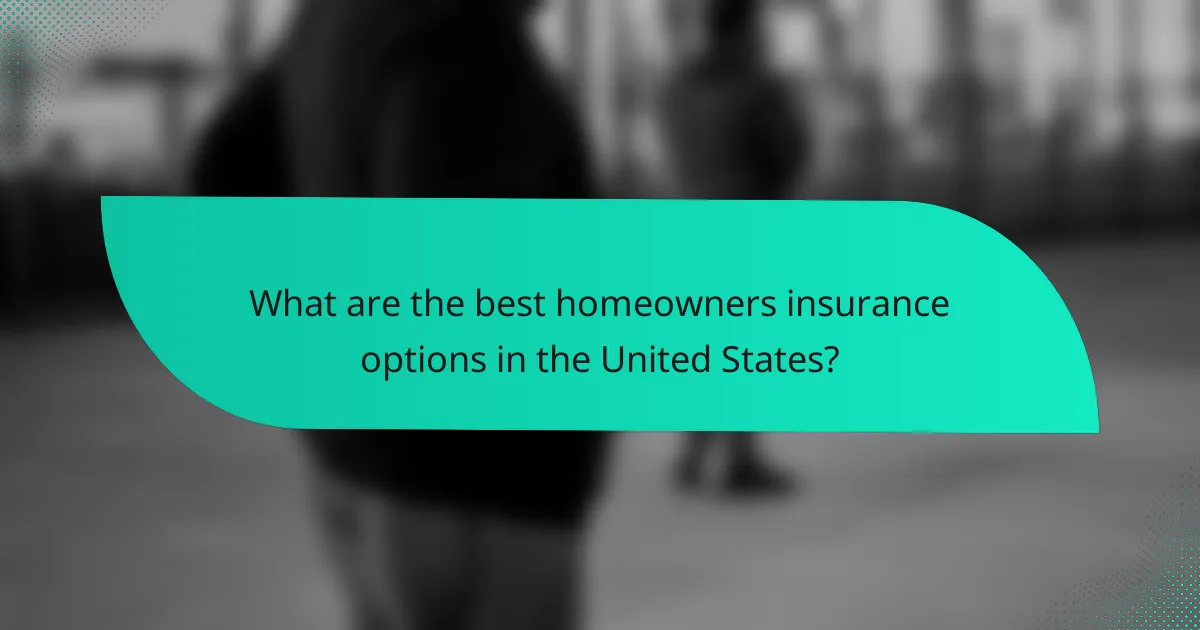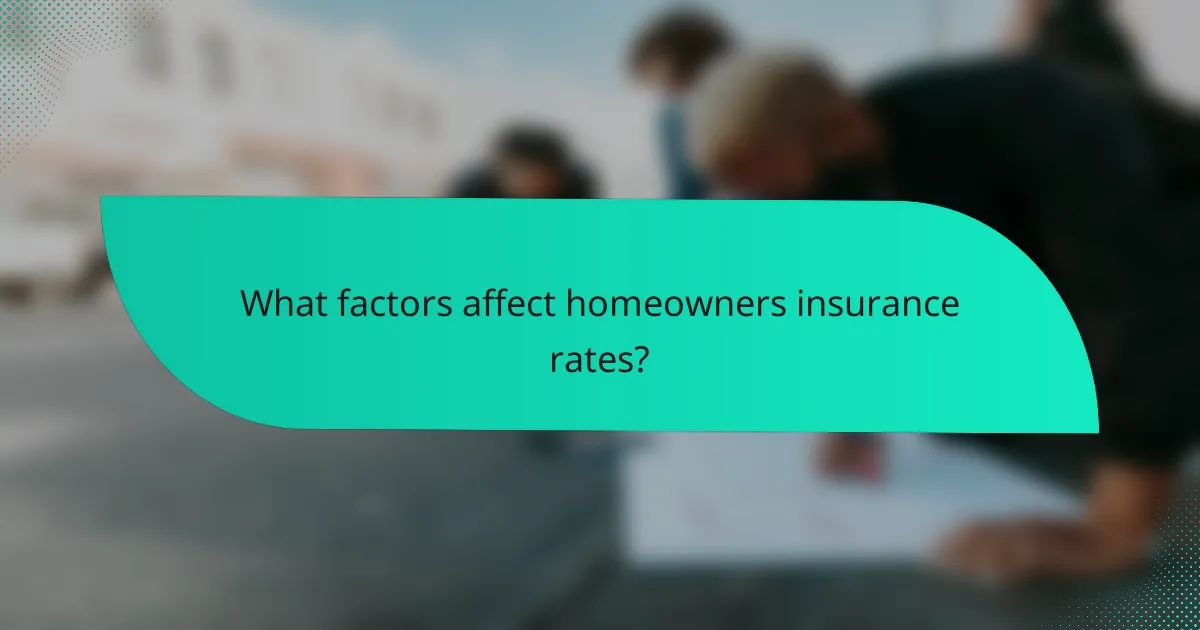Homeowners insurance is essential for protecting your property and ensuring financial security against unexpected events such as damages, theft, and liability claims. By selecting the right policy, you can enhance your coverage while enjoying peace of mind knowing that your home and assets are safeguarded. Understanding the factors that influence insurance rates can also help you make informed decisions and potentially lower your premiums.

What are the best homeowners insurance options in the United States?
The best homeowners insurance options in the United States offer a combination of comprehensive coverage, affordability, and reliable customer service. When choosing a policy, consider factors such as coverage limits, deductibles, and additional endorsements that can enhance your protection.
State Farm homeowners insurance
State Farm is known for its extensive network of agents and customizable policies. They offer a range of coverage options, including dwelling, personal property, liability, and additional living expenses. Customers appreciate the ability to tailor their policies to fit specific needs, such as adding coverage for valuable items.
State Farm also provides discounts for bundling policies, which can lead to significant savings. Their mobile app allows for easy management of policies and claims, enhancing customer convenience.
Allstate homeowners insurance
Allstate offers a variety of homeowners insurance policies with unique features, such as the Claim RateGuard, which prevents premium increases after a claim. Their policies cover standard risks, including fire, theft, and liability, along with options for additional coverage like flood insurance.
Allstate’s extensive online resources and tools help homeowners assess their coverage needs and find potential discounts. Their “Your Choice Home” option allows for flexible coverage limits, making it easier to customize protection based on individual circumstances.
Progressive homeowners insurance
Progressive is recognized for its competitive pricing and user-friendly online quote system. They provide a straightforward approach to homeowners insurance, focusing on essential coverage areas like dwelling and personal property. Progressive also offers a unique feature called “HomeQuote Explorer,” which allows users to compare rates from multiple insurers.
While Progressive may not have as many local agents as some competitors, their online tools and resources make it easy for homeowners to manage their policies. Discounts are available for bundling with auto insurance, which can enhance overall savings.
Farmers homeowners insurance
Farmers Insurance offers a wide range of coverage options, including standard homeowners insurance and specialized policies for unique properties. They provide customizable endorsements such as identity theft protection and equipment breakdown coverage, which can enhance a homeowner’s financial security.
Farmers also emphasizes customer service, with agents available to assist in policy selection and claims processing. Their mobile app allows for easy access to policy details and claims submission, ensuring peace of mind for policyholders.
Liberty Mutual homeowners insurance
Liberty Mutual provides flexible homeowners insurance options with a focus on comprehensive coverage. Their policies cover standard risks and offer additional features like personal property replacement cost and optional flood insurance. Liberty Mutual’s “Better Car Replacement” feature is also available for those who bundle auto and home insurance.
Customers can benefit from various discounts, including those for new homes or homes with safety features. Liberty Mutual’s online tools help homeowners assess their coverage needs and find the best policy to suit their financial situation.

How does homeowners insurance protect your property?
Homeowners insurance protects your property by providing financial coverage for damages, theft, and liability claims. This insurance ensures that you can recover from unexpected events, maintaining both your property and your peace of mind.
Covers property damage
Homeowners insurance typically covers damages to your home and personal belongings caused by events like fire, storms, or vandalism. Depending on your policy, coverage may extend to the structure of your home, detached garages, and other structures on your property.
It’s essential to review your policy to understand what specific types of damage are included and any exclusions that may apply. For instance, standard policies often cover damage from wind and hail but may not include flooding, which requires separate coverage.
Protects against theft
Homeowners insurance offers protection against theft of personal property, helping you recover losses if your belongings are stolen. This coverage typically includes items like electronics, jewelry, and furniture, up to a specified limit.
To ensure adequate protection, consider documenting your valuables with photos and receipts. Some policies may have sub-limits for high-value items, so you might need additional coverage for expensive possessions.
Liability coverage
Liability coverage within homeowners insurance protects you financially if someone is injured on your property or if you accidentally cause damage to someone else’s property. This coverage can help pay for legal fees, medical expenses, and settlements.
Most standard policies offer liability coverage in the range of hundreds of thousands of dollars, but you can opt for higher limits if needed. It’s wise to assess your personal risk factors, such as having a pool or hosting frequent gatherings, to determine the appropriate level of coverage.

What factors affect homeowners insurance rates?
Homeowners insurance rates are influenced by various factors, including the location of the property, its value, the age and condition of the home, and the homeowner’s credit score. Understanding these elements can help you anticipate costs and find ways to lower your premiums.
Location and property value
The geographical location of your home plays a significant role in determining insurance rates. Areas prone to natural disasters, such as floods or earthquakes, typically have higher premiums due to increased risk. Additionally, the overall property value affects the cost; more expensive homes generally require higher coverage limits, leading to increased rates.
Consider researching local crime rates and the prevalence of natural disasters in your area. Homes in safer neighborhoods or regions with lower disaster risks may enjoy lower insurance costs. It’s also wise to compare rates from different insurers to find the best deal based on your location.
Home age and condition
The age and condition of your home can significantly impact your insurance premiums. Older homes may have outdated electrical systems, plumbing, or roofing, which can increase the risk of damage and lead to higher rates. Insurers often assess the condition of your home to determine the likelihood of claims.
To potentially lower your rates, consider investing in renovations or updates that improve safety and efficiency. Regular maintenance can also keep your home in good condition, reducing the risk of damage and claims, which may lead to lower premiums over time.
Credit score impact
Your credit score can influence your homeowners insurance rates, as insurers often view it as an indicator of risk. A higher credit score typically correlates with lower premiums, while a lower score may result in higher costs. Insurers believe that individuals with better credit are less likely to file claims.
To improve your credit score, focus on paying bills on time, reducing debt, and monitoring your credit report for errors. Maintaining a good credit score not only helps with insurance rates but can also benefit you in other financial areas, such as securing loans or mortgages.

What are the common exclusions in homeowners insurance?
Homeowners insurance typically excludes certain types of damage and liability, which can significantly affect your coverage. Understanding these exclusions is crucial for ensuring you have adequate protection for your property and finances.
Flood damage
Flood damage is one of the most common exclusions in homeowners insurance policies. Standard policies do not cover damage caused by flooding, which can result from heavy rainfall, storm surges, or melting snow. Homeowners in flood-prone areas should consider purchasing a separate flood insurance policy through the National Flood Insurance Program (NFIP) or private insurers.
When assessing flood risk, consider factors such as your property’s location, elevation, and historical flood data. Many lenders require flood insurance for homes in designated flood zones, so it’s essential to check your local regulations and requirements.
Earthquake damage
Earthquake damage is generally excluded from standard homeowners insurance policies. Homeowners living in seismically active regions should seek additional earthquake coverage to protect against potential losses. This coverage can be obtained through endorsements to your existing policy or separate earthquake insurance policies.
When evaluating earthquake insurance, consider the deductible, which can be significantly higher than standard policies, often ranging from 10% to 20% of the home’s value. Additionally, review the coverage limits to ensure they align with your property’s replacement cost.
Negligence claims
Negligence claims may not be covered under homeowners insurance if the damage results from the homeowner’s failure to maintain the property. For example, if a tree falls on a neighbor’s house due to neglect, the homeowner may be liable for damages. It’s crucial to maintain your property to avoid potential claims.
To mitigate negligence risks, regularly inspect your property for hazards, such as damaged roofs or unstable trees. Keeping thorough records of maintenance can also help demonstrate your diligence in case of a claim.

How to choose the right homeowners insurance policy?
Choosing the right homeowners insurance policy involves understanding your coverage needs, evaluating different options, and considering factors such as premiums and deductibles. Focus on policies that provide adequate protection for your property and financial security.
Assess coverage needs
Start by evaluating the value of your home and personal belongings to determine the amount of coverage you require. Consider factors such as the cost of rebuilding your home, the value of your possessions, and any additional structures on your property.
It’s also essential to assess your risk factors, including location, natural disaster susceptibility, and crime rates. For example, homes in areas prone to floods or earthquakes may need additional coverage, which can affect your policy choice.
As a general rule, aim for a policy that covers at least 80% of your home’s replacement cost. This ensures you have sufficient protection in case of a total loss, helping to maintain your financial security and peace of mind.
